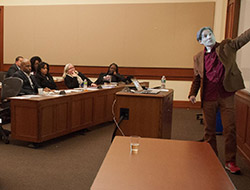Handling a Crisis with Class
“We had a foot and a half of sewage on the main floor,” said Brian O’Connell, the principal. An alumnus of TC’s Cahn Fellows Program for Distinguished Principals, he was sharing his story at a gathering organized by the program in late January. The event, held in the Gottesman Libraries, featured testimonials from educators whose schools were affected by the storm, and observations on the theme of resilience by TC psychologist George Bonanno.
Resilience, O’Connell said, was the hallmark of his students in the wake of the storm. Their lives had been up-ended, scattering them “all over the map.” The school itself was assigned temporary quarters at two other schools in East New York.– and for O’Connell and his staff, just locating the students posed a huge challenge, let alone getting them to these sites. “We were worried they might enroll elsewhere, and not come back,” O’Connell said.
Preventing that scenario required hiring 12 yellow buses to serve seven pick-up points across Brooklyn and Queens, procuring 400 folding chairs, and, at one point, packing 98 kids into a classroom. Somehow Scholars pulled it off. One morning soon after the storm, O’Connell boarded a bus and asked how many students on board had heat or hot water. No hands went up. Then he asked how many were ready to go to school. “Every hand went up,” he said. “And it hit me: These kids are strong. Rockaway Resilient. And that became our motto.”
Other educators shared similar stories. At P.S. 15 in Red Hook, Brooklyn, the basement flooded, knocking out heat and power facilities. Principal Peggy Wyns-Madison refused an order to take her 380 students and 90 staff to a school in distant Canarsie, asking a counterpart at a school close by to take them in instead. “It was a big ask, but I wanted to keep the children close to home,” she said.
At the Dr. Susan S. McKinney Secondary School of the Arts in downtown Brooklyn, Principal Paula Holmes set up visitation rooms after realizing that parents from hard-hit areas were coming to school to see kids they’d sent to stay with relatives. At Thanksgiving, McKinney students and staff helped bring 1,000 meals to families in Coney Island.
Elsewhere, it was staff who endured the greatest hardship – for instance at Cleaveland High school in Queens, where Principal Denise Vittor said she and 11 colleagues were still not back in their own homes, in Long Beach, L.I. and other areas. John Jenkins of the School Leaders Network said he’d heard many similar cases. “School leaders, tend to think of themselves last,” he said. “But they have to make sure to take time, to close the door and let it all out.”
Bonanno, the director of TC’s Loss, Trauma & Emotion Lab, called these stories impressive, poignant, and largely consistent with his long-term research on individuals’ response to traumatic events. His work suggests that responses usually cluster in four patterns. One group experiences chronic psychological damage, another slow but steady recovery, and a third shows delayed effects after a period of seeming to cope. Fortunately, however, most people fall into the fourth group, which consists of resilient individuals who make their way through the crisis and aftermath without discernible damage.
Multiple factors contribute to making some individuals resilient and others not, Bonanno said. These might include levels of stress, diversity in resources and backgrounds, and the amount and quality of support received – all of which could vary a great deal according to neighborhood, school and type of crisis.
Wyns-Madison said she found Bonanno’s main message – that most
people are resilient – “hopeful” and in tune with what she saw at P.S. 15. But
with only three months elapsed since the storm, she worried about the
delayed-onset pattern that Bonanno’s research predicts for some people. “I
still have children who have basic needs that are in disarray,” she said. “I
will pay attention to them more closely, and look at the ways that my
counselors can assist.”
Published Tuesday, Feb. 12, 2013
